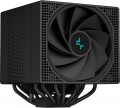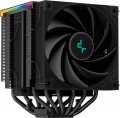Fan size
The diameter of the fan(s) used in the cooling system.
In general, larger fans are considered more advanced than smaller ones: they allow you to create a powerful air flow at a relatively low speed and low noise level. On the other hand, a large diameter means large dimensions, weight and price. As for specific figures,
40 mm and
60 mm models are considered miniature,
80 mm and
92 mm are medium,
120 mm and
135 /
140 mm are large, and even
200 mm fans are found in the most powerful
case systems.
Max. RPM
The highest speed at which the cooling system fan is capable of operating; for models without a speed controller (see below), this item indicates the nominal rotation speed. In the "slowest" modern fans, the maximum speed
does not exceed 1000 rpm, in the "fastest" it can be up
to 2500 rpm and even
more.
Note that this parameter is closely related to the fan diameter (see above): the smaller the diameter, the higher the speed must be to achieve the desired airflow values. In this case, the rotation speed directly affects the level of noise and vibration. Therefore, it is believed that the required volume of air is best provided by large and relatively "slow" fans; and it makes sense to use "fast" small models where compactness is crucial. If we compare the speed of models of the same size, then higher speeds have a positive effect on performance, but increase not only the noise level, but also the price and power consumption.
Max. air flow
The maximum airflow that a cooling fan can create; measured in CFM — cubic feet per minute.
The higher the CFM number, the more efficient the fan. On the other hand, high performance requires either a large diameter (which affects the size and cost) or high speed (which increases the noise and vibration levels). Therefore, when choosing, it makes sense not to chase the maximum air flow, but to use special formulas that allow you to calculate the required number of CFM depending on the type and power of the cooled component and other parameters. Such formulas can be found in special sources. As for specific numbers, in the most modest systems, the performance
does not exceed 30 CFM, and in the most powerful systems it can be up to 80 CFM and even
more.
It is also worth considering that the actual value of the air flow at the highest speed is usually lower than the claimed maximum; see Static Pressure for details.
Static pressure
The maximum static air pressure generated by the fan during operation.
This parameter is measured as follows: if the fan is installed on a blind pipe, from which there is no air outlet, and turned on for blowing, then the pressure reached in the pipe will correspond to the static one. In fact, this parameter determines the overall efficiency of the fan: the higher the static pressure (ceteris paribus), the easier it is for the fan to “push” the required amount of air through a space with high resistance, for example, through narrow slots of a radiator or through a case full of components.
Also, this parameter is used for some specific calculations, however, these calculations are quite complex and, usually, are not necessary for an ordinary user — they are associated with nuances that are relevant mainly for computer enthusiasts. You can read more about this in special sources.
Noise level
The standard noise level generated by the cooling system during operation. Usually, this paragraph indicates the maximum noise during normal operation, without overloads and other "extreme".
Note that the noise level is indicated in decibels, and this is a non-linear value. So it is easiest to evaluate the actual loudness using comparative tables. Here is a table for values found in modern cooling systems:
20 dB — barely audible sound (quiet whisper of a person at a distance of about 1 m, sound background in an open field outside the city in calm weather);
25 dB — very quiet (normal whisper at a distance of 1 m);
30 dB — quiet (wall clock). It is this noise that, according to sanitary standards, is the maximum allowable for constant sound sources at night (from 23.00 to 07.00). This means that if the computer is planned to sit at night, it is desirable that the volume of the cooling system does not exceed this value.
35 dB — conversation in an undertone, sound background in a quiet library;
40 dB — conversation, relatively quiet, but already in full voice. The maximum permissible noise level for residential premises in the daytime, from 7.00 to 23.00, according to sanitary standards. However, even the noisiest cooling systems usually do not reach this indicator, the maximum for such equipment is about 38 – 39 dB.
Heat pipes
Number of heat pipes in the cooling system
The heat pipe is a hermetically sealed structure containing a low-boiling liquid. When one end of the tube is heated, this liquid evaporates and condenses at the other end, thus removing heat from the heating source and transferring it to the cooler. Nowadays, such devices are widely used mainly in processor cooling systems (see "Intended use") — they connect the substrate that is in direct contact with the CPU and the heatsink of the active cooler. Manufacturers select the number of tubes based on the overall performance of the cooler (see "Maximum TDP"); however, models with similar TDPs can still differ markedly in this parameter. In such cases, it is worth considering the following: increasing the number of heat pipes increases the efficiency of heat transfer, but also increases the dimensions, weight and cost of the entire structure.
As for the number, the simplest models provide
1 – 2 heat pipes, and in the most advanced and powerful processor systems, this number can be
7 or more.
Display
Remote or built
-in information display in the design of the cooling system. The screen is used to display information about temperature, fan speed, voltage, etc. In advanced implementations, the display can be used to control cooling parameters to ensure optimal system performance and stability.
Lighting
The presence
of its own illumination in the design of the cooling system.
The backlight serves a purely aesthetic function — it gives the device a stylish appearance that blends well with other components in the original design. Thanks to this, such cooling systems are especially appreciated by gamers and fans of external PC modding — especially since the lighting can be different, and the most advanced models even provide backlight synchronization with other components (see below). On the other hand, this function does not affect the efficiency and performance, and the overall cost is inevitably affected, sometimes quite noticeably. Therefore, if the appearance does not play a fundamental role for you, the best choice, most likely, will be
a cooling system without backlight.
Lighting colour
The colour of the backlight installed in the cooling system.
See above for more details on the backlight itself. Also note here that in the illumination of modern cooling systems there is both one colour (most often
red or
blue, less often
green,
yellow,
white or
purple), and multi-colour systems such as
RGB and
ARGB. The choice of a single-colour backlight depends mainly on aesthetic preferences, but the last two varieties should be touched upon separately.
The basic principle of operation of both RGB and ARGB systems is the same: the design provides for a set of LEDs of three basic colours — red (Red), green (Green) and blue (Blue), and by changing the number and brightness of the included LEDs, you can not only intensity, but and tint of light. The difference between these options differs in functionality: RGB systems support a limited set of colours (usually up to one and a half dozen, or even less), while ARGB allows you to choose almost any shade from the entire available colour range. At the same time, both of them can support backlight synchronization (see below); in general, this function is not required for RGB and ARGB systems, but it is used almost exclusively in them.

